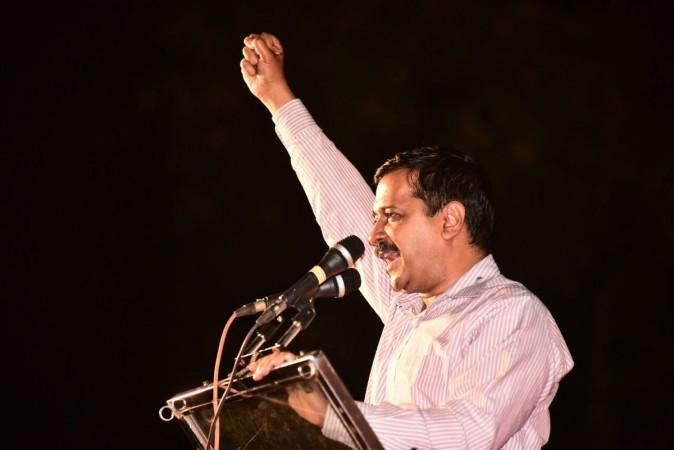
The Electronic Voting Machines (EVMs) that made their debut in India in the Kerala by-elections in 1982, have come under increasing attack from political losers.
Irrespective of their political colour, parties have targeted EVMs whenever they have lost elections, seeking steps to rectify the 'ills'.
In 2009, after the BJP lost their second successive election, a flabbergasted Lal Krishna Advani questioned the EVMs' efficiency and sought their suspension till they were proved to be accurate. Besides the BJP, the Left, RJD, LJP, JD(S) and SP also favoured a review of the EVMs' functioning.
In 2017, leaders like Arvind Kejriwal of the Aam Aadmi Party, Mayawati of the BSP and Mamata Banerjee of the Trinamool Congress have raised similar questions after results of crucial Assembly elections came out against them.
The BJP, which came out winners this time around, are silent this time, just like Kejriwal was after sweeping the Delhi polls in 2015; or Mayawati after winning a majority in the 2007 UP polls.
Former Uttarakhand chief minister Harish Rawat also made the same allegations this time, though his party, the Congress, called Advani's EVM charges in 2009 "childish".
Is finding a fault with EVMs a last-ditch effort by politicians finding it immensely difficult to survive the Narendra Modi blitzkrieg?
The Election Commission of India reiterated that EVMs cannot be tampered with under any circumstances and hence there is no reason to question the sanctity of the electoral process.
History of the EVM
The use of the ballot papers in elections in India came increasingly under scrutiny over the years, as a result of which the EC mooted the idea of the electronic machine in 1977. The law was amended by Parliament in December 1988 and a new section – 61A – was inserted in the Representation of the People Act, 1951, empowering the poll panel to use EVMs in the general elections.
The amended law came into force on March 15, 1989.
In January 1990, the Government of India appointed the Electoral Reforms Committee comprising members from several parties – national and regional.
The committee set up a technical expert committee to evaluate the EVMs and it gave them the nod. Since 2000, the EVMs have been used in more than 100 assembly elections and three general elections.
Then came the allegations of tampering
The allegations of EVM tampering were not raised for the first time in 2009.
A number of high courts were moved over the issue between 2001 and 2004 (Madras, Delhi, Karnataka, Kerala and Bombay) and each time, the courts ruled favour of the machines' reliability. The Karnataka High Court even went to the extent of calling the EVMs a "national pride".
The Madras High Court observed: "There is also no question of introducing any virus or bugs for the reason that the EVMs cannot be compared to personal computers. The programming in computers, as suggested, has no bearing with the EVMs. The computer would have inherent limitations having connections through Internet and by their very design, they may allow the alteration of the programme but the EVMs are independent units and the programme in EVM is entirely a different system."
Even the Supreme Court dismissed appeals that were filed against the high courts' verdicts.
It was admitted before the judiciary that the data or technique used in the EVMs in India was not vulnerable to piracy and nobody could gain unauthorised access to them. None of the parties alleging tampering with EVMs have been able to prove their charges before the courts.
Some activists still went to the apex court and when they were directed by the latter to meet the EC officials on the matter, it openly challenged them to prove that the EVMs could be tampered with.
The activists tried, but none could tamper with them.
The commission also invited people who were sceptical of EVMs to physically demonstrate the allegations they had been making.
One hundred machines were brought from 10 states and kept at the EC's office to be scrutinised. The EVMs were taken in for 'tampering' in the presence of technical experts and representatives from EVM-manufacturing firms.
The demonstration to show that the EVMs could be tampered with failed. One EVM unit was even brought to a television channel by a group of activists stating it was proof that EVMs could be tampered with, but the EC countered by saying that as the machine had been stolen from a warehouse in Mumbai and manipulated, it was no the machine it uses for elections.
Why EVMs cannot be tampered with
EVMs have certain features that ensure that no kind of tampering is possible. Here are some:
(a) The machine is electronically immune from tampering. The software in the machines is burnt into a OTP (one time programmable) chip which ensures that it can't be manipulated.
(b) The machines have no wire/wireless networking with any other machine and hence there is zero possibility of it being manipulated.
(c) The EVMs' software is developed in-house by a select group of people – engineers in BEL and ECIL independently. An exclusive group of technical experts is responsible for developing the source code and the work is never outsourced.
(d) After design, the software is tested and evaluated by an independent testing group in accordance with the software requirement specifications. This means the software cannot be tampered with for any other purpose.
(e) The software has been coded in such a way that a voter can cast his ballot only once. The vote can be recorded only after the presiding officer enables the ballot on the control unit. The machine doesn't receive any signal from any other place whatsoever.
(f) The EVMs used in India cannot be compared with those in other countries where their usage has been stopped. It is because most of the systems used in other countries are computer-based with Internet connectivity and hence they can be tampered with.
The EC has ensured an elaborate administrative system of security measures and procedural checks and balances to prevent any kind of misuse of EVMs. Adequate measures are taken ahead of polling to ensure that the polling is fair.
But even then, the losers in elections are not convinced. They would do themselves and their parties a favour by addressing the real issues that saw them biting the dust. Barking up the wrong tree will not help much.











